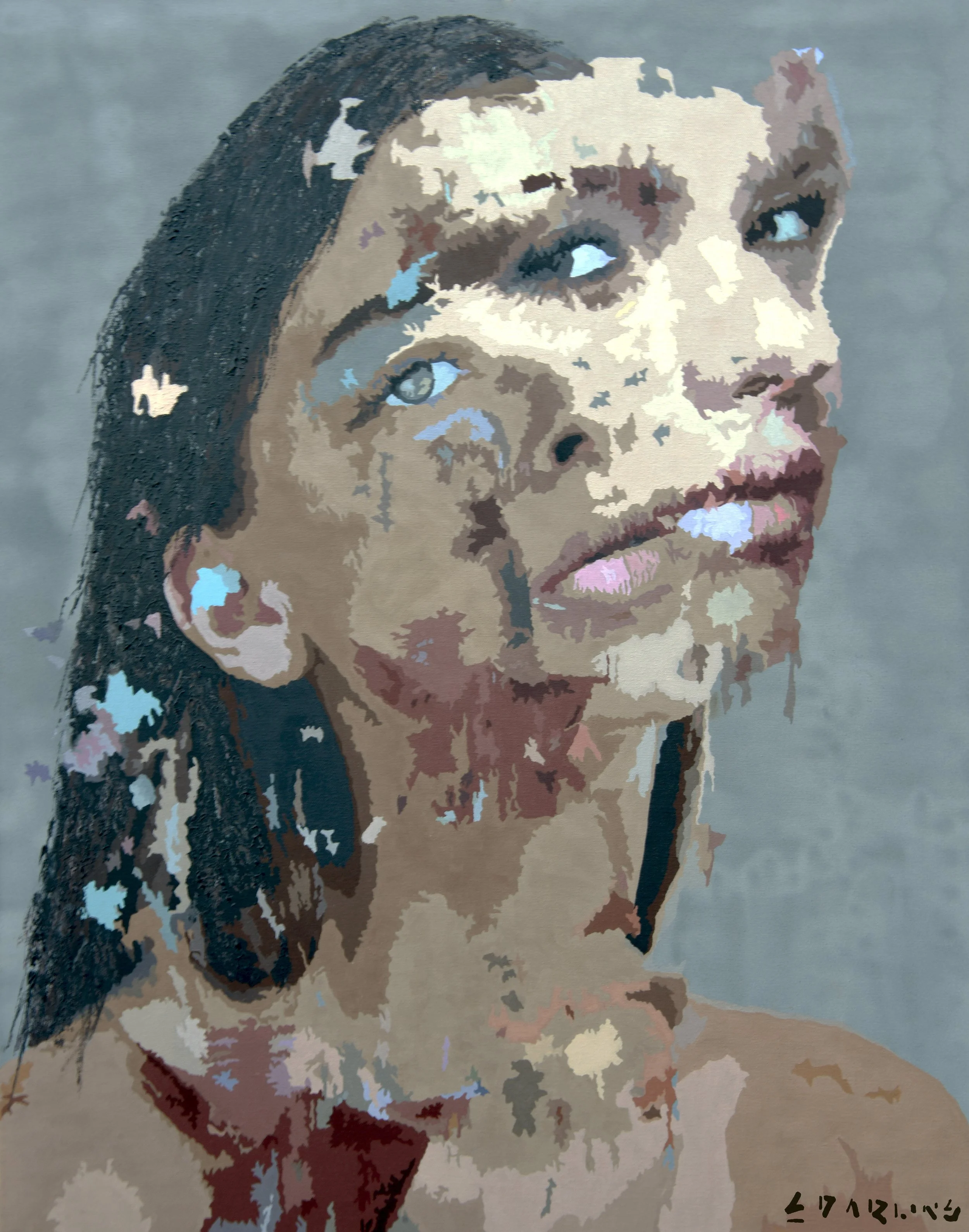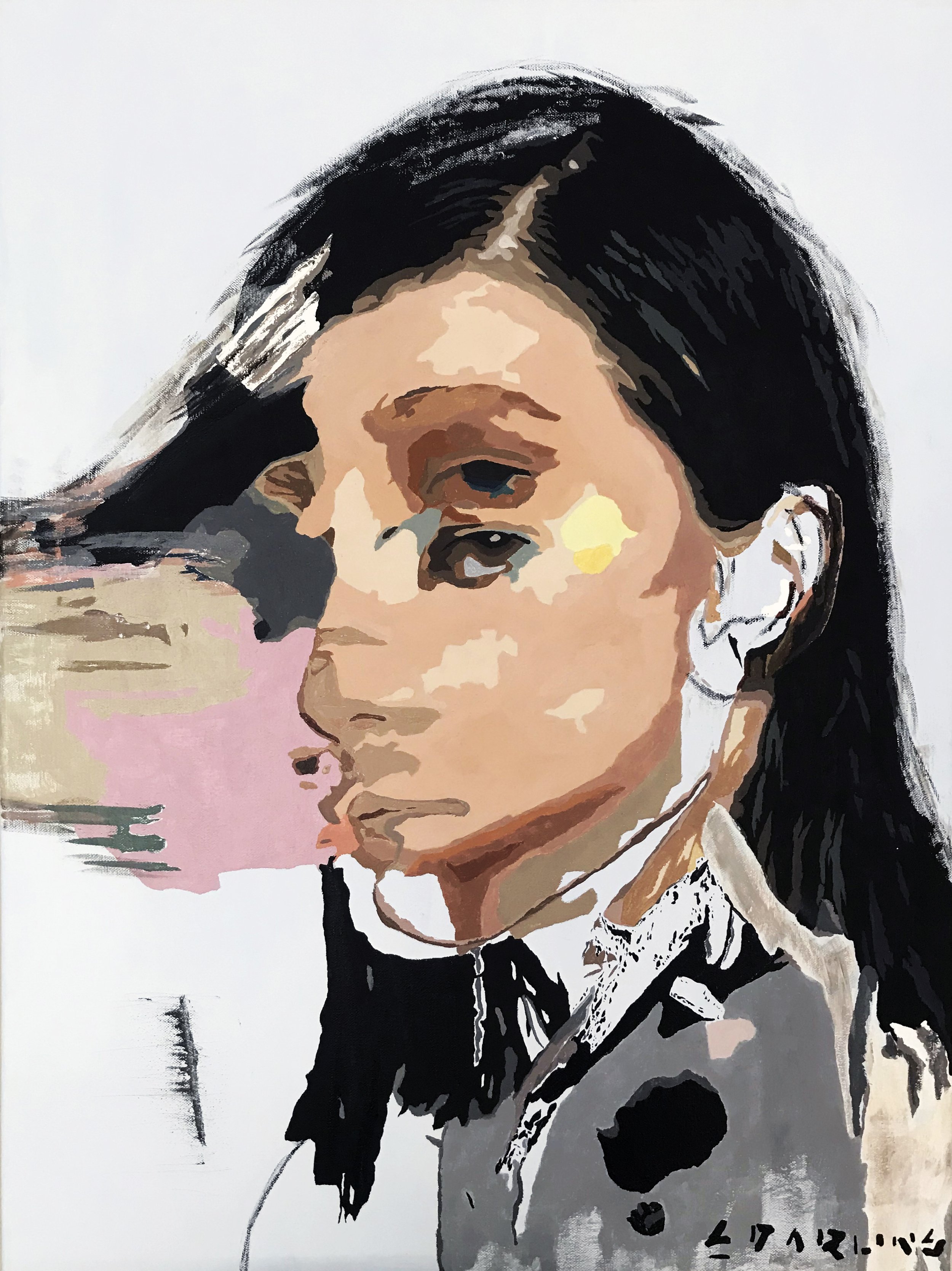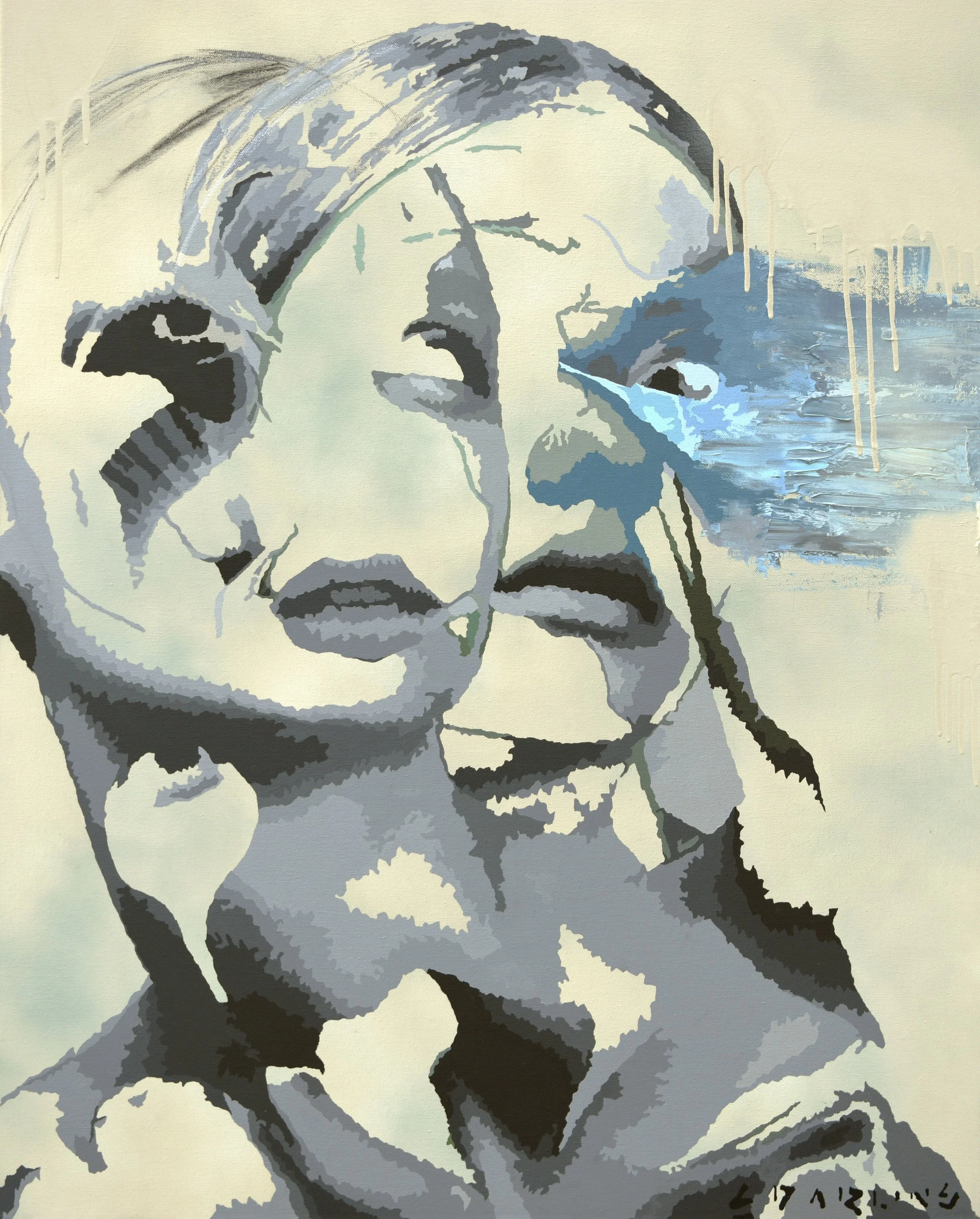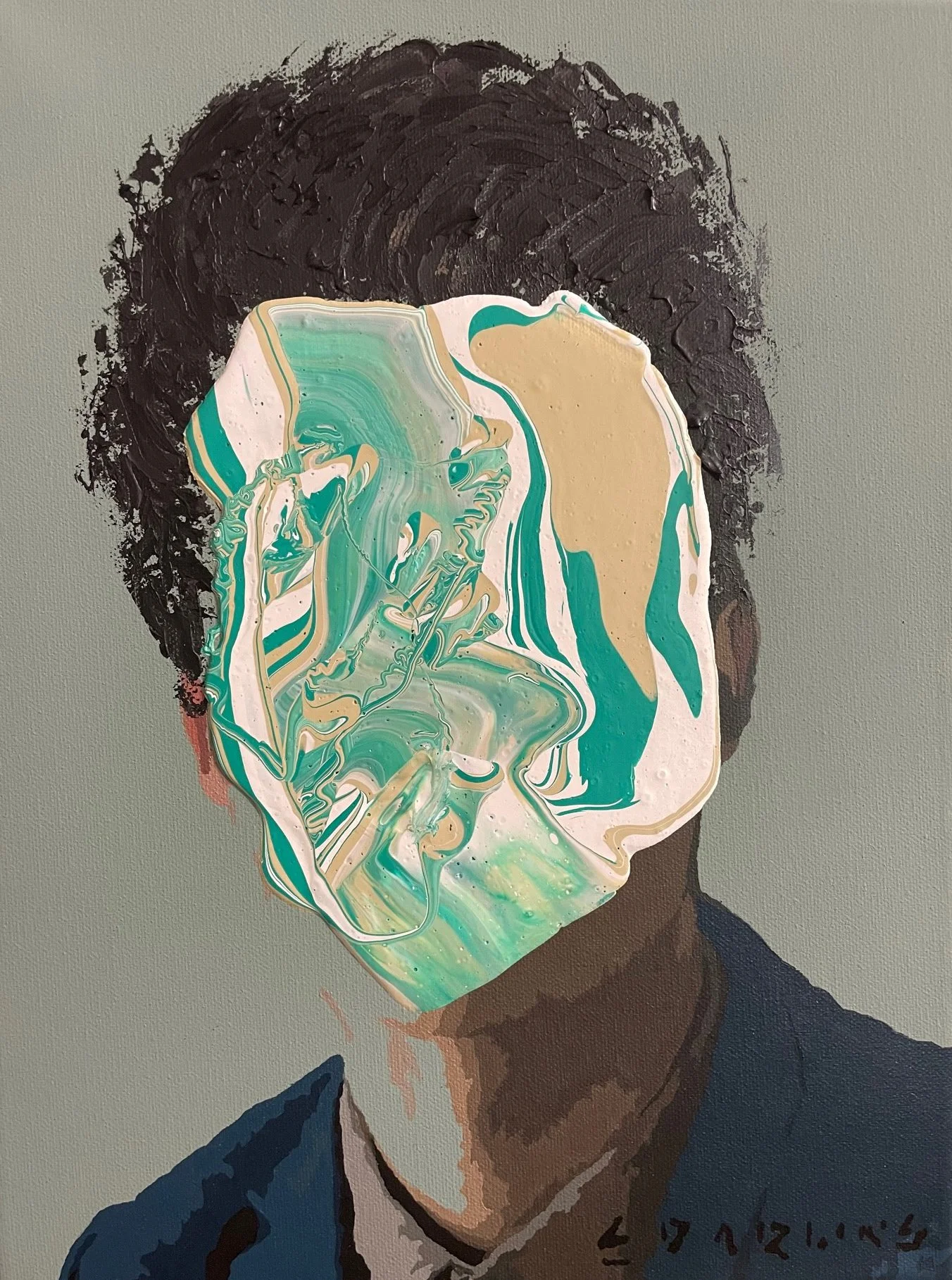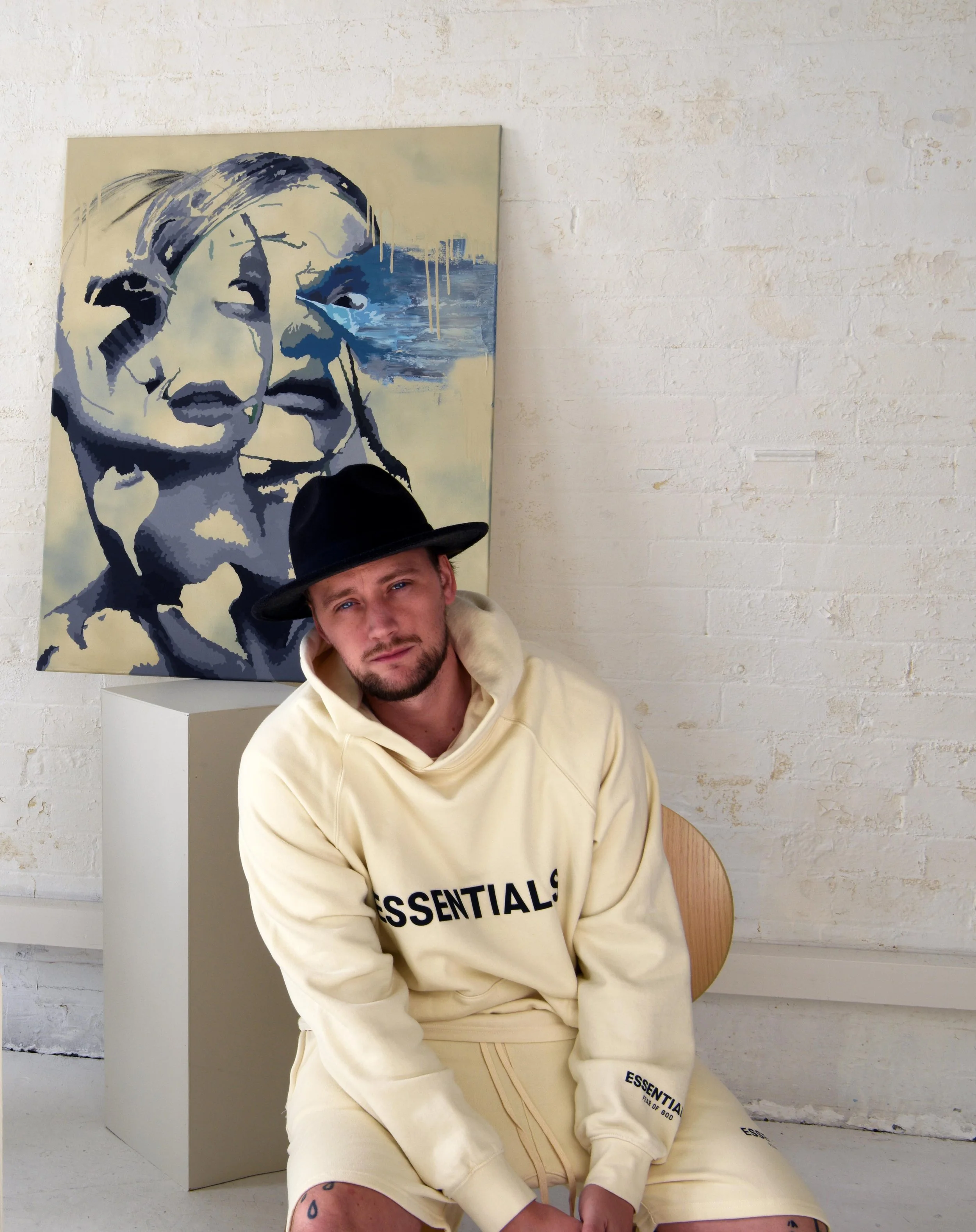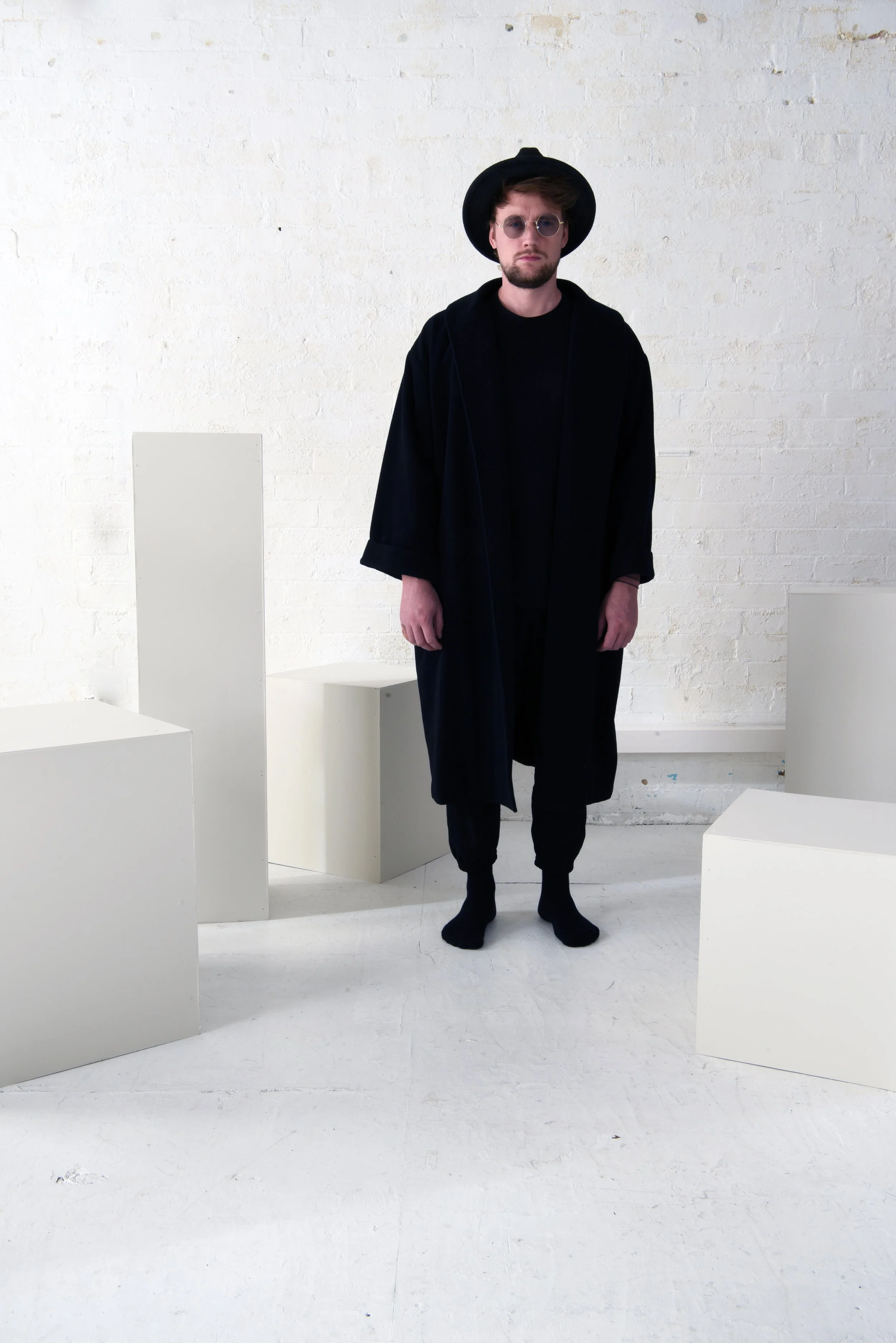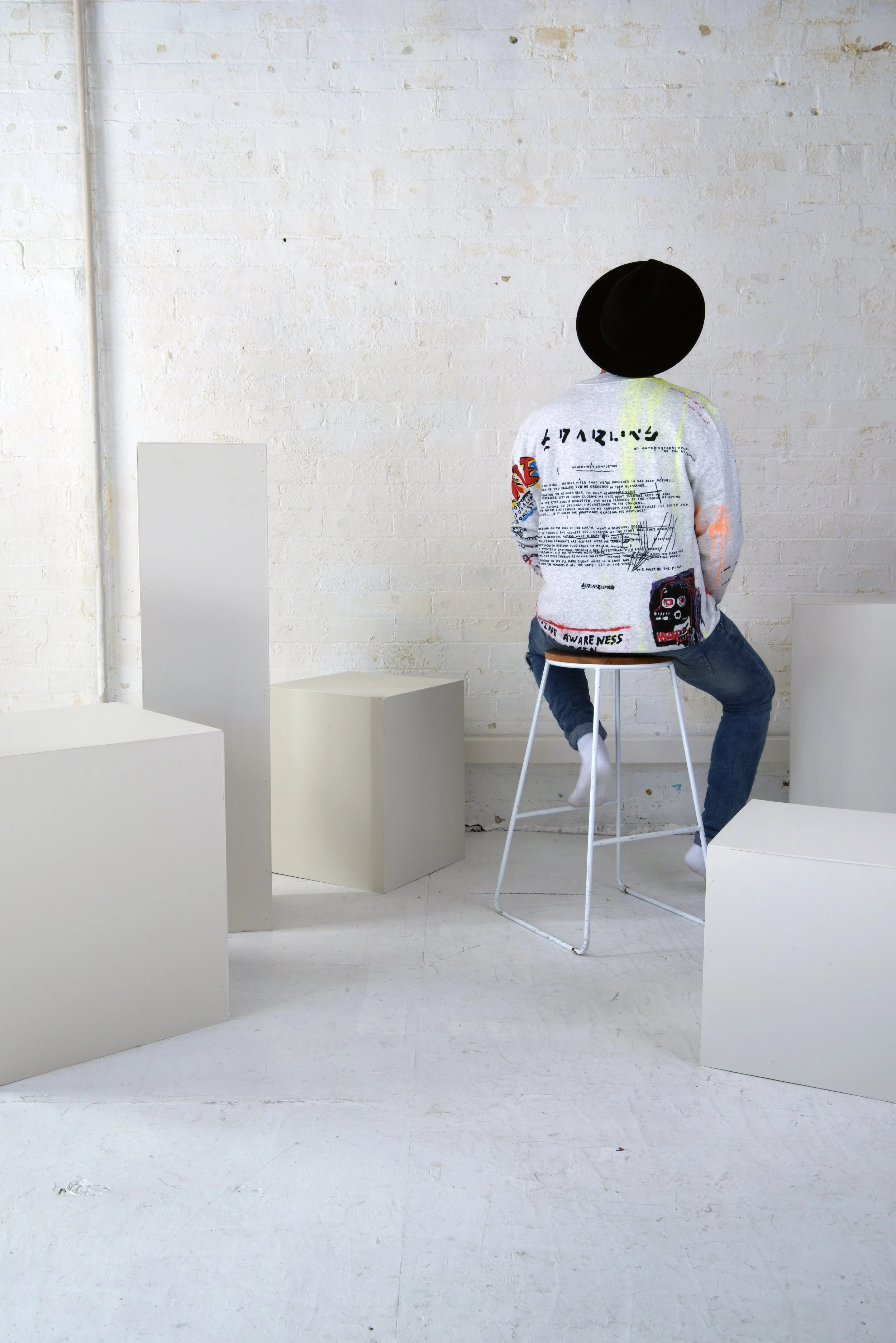INTERVIEW WITH Simon Darling
Growing up with a mother who was an emerging abstract artist, how did her creative nature influence your initial interest and development in art?
My journey into the world of art is intricately woven with the influence of my mom and her innate creativity. From the very beginning, she provided a nurturing environment that encouraged exploration, imagination, and self-expression.
My mom, herself a creative soul, instilled in me a deep appreciation for the arts. Our home was filled with colors, textures, and a constant flow of creative energy. Whether it was her own artistic endeavors or exposing me to various forms of art, she cultivated an environment that fueled my curiosity and sparked my initial interest in the world of creativity.
As a child, I often found myself drawn to the art supplies my mom used for her projects. The simple act of watching her create, whether it was painting, crafting, or experimenting with new techniques, was a magical experience. It was in those moments that I discovered the power of art to convey emotions, tell stories, and capture the beauty of the world around us.
My mom's encouragement played a pivotal role in the development of my artistic skills. She recognized and nurtured my early interest, providing me with the tools and support to experiment and learn. From the joy of finger painting to more structured art lessons, she fostered an environment where I could freely express myself and find my own artistic voice.
Her creative nature became a profound source of inspiration for me. It taught me that art is not just about technique but about embracing one's unique perspective and allowing that perspective to shine through in the creative process. This foundational lesson has stayed with me throughout my artistic journey, influencing how I approach every canvas, sculpture, or project.
Looking back, I see that my mom's influence extends beyond the technical aspects of art. It encompasses a mindset—a way of seeing the world as a canvas for endless possibilities. Her creative spirit has shaped not only my artistic skills but also my appreciation for the transformative power of art in our lives. In many ways, I owe my passion for art to the beautiful tapestry of creativity that my mom wove around me, inspiring me to embark on a lifelong journey of artistic exploration and expression.
You're known for your deep, obscure, and expressive portraits. Can you describe the journey that led you to this distinctive style, and how your early experiences in drawing and painting shaped this path?
The evolution of my distinctive style of deep, obscure, and expressive portraits has been a journey deeply rooted in my early experiences with drawing and painting. From the beginning, art has been my language of introspection, a means to explore the profound layers of the human psyche.
As a young artist, I was drawn to the intricacies of the human face and its ability to convey a myriad of emotions. My early experiences in drawing and painting were marked by an intense desire to capture not just the physical likeness but also the inner essence of my subjects. I found that the true essence often lies in the shadows, the nuances, and the unspoken emotions.
These formative years were marked by a constant exploration of different techniques and styles. I was fascinated by the play of light and shadow, the interplay of colors, and the expressive potential of various brushstrokes. This experimentation laid the foundation for what would later become my signature style, marked by its depth and obscurity.
My interest in psychology, philosophy and the mysteries of the human mind further fueled my artistic exploration. I delved into the works of thinkers and philosophers, seeking inspiration from the complexities of the human experience. This intellectual journey became a rich source of thematic material for my portraits, infusing them with layers of meaning and emotion.
Over time, my style evolved to embrace the obscure and the enigmatic. I discovered the power of pushing artistic boundaries, both in terms of technique and subject matter, to evoke a visceral response from the viewer. Faces became a canvas for the exploration of the unknown, a reflection of the hidden facets within each of us.
Today, my portraits stand as evidence to this artistic odyssey. Each painting’s expression is a deliberate choice to peel back the layers and reveal the profound and mysterious aspects of the human soul. My early experiences in drawing and painting laid the groundwork for this distinctive path, fostering a deep appreciation for the evocative power of art and its ability to convey the ineffable aspects of our shared human experience.
Despite being an art school dropout, you hold a degree in Architectural Technology and Design. How has this background influenced your approach to art, particularly in your portrait work?
My degree in Architectural Technology and Design has been a profound influence on my approach to art, particularly in the realm of portraiture. The principles and perspectives instilled in me through my architectural education have significantly shaped the way I conceptualize and execute my artistic endeavors.
Architecture, with its emphasis on form, structure, and dimensional relationships, has flawlessly merged itself into my portrait work. The meticulous attention to detail and a deep understanding of proportions that I cultivated during my studies have become integral components of my artistic process. Each stroke and contour in my portraits is informed by a sense of architectural precision, creating compositions that are not only aesthetically pleasing but also grounded in a structural integrity that reflects my architectural background.
One key aspect of my approach is the consideration of negative space and its impact on the overall composition. The interplay between light and shadow referring to the colour changes is a fundamental element in both architecture and portraiture, which takes center stage in my work. I leverage the principles of light and shadow to sculpt the features of my subjects, creating a dynamic and visually compelling narrative within each portrait.
Additionally, my architectural training has heightened my appreciation for the emotional resonance of spaces. This awareness translates into my portraits, where I aim to evoke a sense of atmosphere and mood through the careful manipulation of dimensional elements. The backgrounds and settings in my portraits are not arbitrary; they are deliberate choices meant to contribute to the overall narrative and emotional impact of the piece.
The interdisciplinary nature of my education has also fostered a sense of innovation in my artistic practice. I often find myself experimenting with unconventional colours combinations, material and techniques, drawing inspiration from the fusion of art and technology that is inherent in architectural design.
In essence, my degree in Architectural Technology and Design has provided me with a unique lens through which I approach portraiture. It has enriched my artistic palette, offering a structured yet creative framework that allows me to merge the precision of architecture with the emotive power of portraiture. This synthesis has become a defining feature of my work, creating a bridge between two seemingly disparate fields and allowing me to explore the intersection of art and architecture in a deeply personal and expressive manner.
Your study of advanced psychology and philosophy is evident in your work. Can you elaborate on how these disciplines inform your artistic process and the themes you explore in your portraits?
My background in advanced psychology and philosophy has profoundly shaped my artistic process, infusing my work with layers of depth, meaning and confusion. These disciplines serve as not just influences but as integral components of my creative exploration, guiding the themes I choose to explore in my portraits.
Psychology, with its profound understanding of the human mind, has become a wellspring of inspiration for my portraiture. I delve into the intricacies of emotions, personalities, and the subtle nuances that define the human experience. This psychological lens allows me to create portraits that go beyond mere visual representation, aiming to capture the essence of the inner worlds of my subjects. Each expression, every motion, becomes a psychological exploration, inviting viewers to connect with the emotional settings within the portraits.
Philosophy, on the other hand, serves as a guiding force in shaping the conceptual foundations of my work. Themes rooted in existentialism, metaphysics, and the exploration of consciousness find their way into my portraits. I use the canvas as a philosophical space, inviting viewers to ponder the complexities of human existence and the interplay between identity, perception, and reality.
The intersection of psychology and philosophy in my artistic process is evident in the thematic threads that run through my portraits. I often explore the concept of the self, the fragility of identity, and the existential questions that define our existence. Each portrait becomes a visual meditation on the profound and often perplexing aspects of what it means to be human navigating life.
In essence, my portraits are not just visual representations but reflections of a deeper exploration into the human psyche and the profound questions that have captivated philosophers throughout history. The marriage of psychology and philosophy in my artistic practice opens a doorway to contemplation, inviting viewers to engage with the intellectual and emotional dimensions within each portrait. Through this interdisciplinary approach, I aim to create art that not only captures the gaze but also stimulates the mind, fostering a dialogue between the observer and the complex and confusing themes that define the human experience.
You've lectured on artistic philosophy. How would you describe your personal philosophy when it comes to creating art, and how does this philosophy manifest in your works?
My personal philosophy when it comes to creating art is deeply rooted in the belief that art serves as a profound means of expression, exploration, and connection. Through my journey as both an artist and a lecturer on artistic philosophy, I've come to see art not only as a visual endeavor but as a dynamic dialogue between the creator, the artwork, and the observer.
At its core, my philosophy embraces the idea that art should transcend the surface, provoking thought, evoking emotions, and stimulating contemplation. I see each canvas or sculpture as a narrative, a visual story that invites viewers to engage on multiple levels. My artistic process is a deliberate endeavor to infuse layers of meaning, inviting observers to explore the nuanced concepts and emotions embedded in the work.
The themes that permeate my philosophy often revolve around the interplay between the seen and the unseen, the known and the unknown. I'm intrigued by the concept of ambiguity and how it can serve as a fertile ground for interpretation and introspection. This manifests in my works through subtle symbolism, intricate details, and a deliberate use of space that allows for a sense of openness and interpretation.
Having lectured on artistic philosophy, I've developed a keen awareness of the power that symbols and metaphors hold in conveying complex ideas. My works often feature elements from students’ questions that act as visual metaphors, encouraging viewers to navigate their own meanings and connections within the artistic narrative. This interplay between the concrete and the symbolic becomes a central tenet of my artistic philosophy.
Furthermore, my philosophy underscores the importance of authenticity and a genuine connection with the creative process. I strive to create art that reflects my personal experiences, emotions, thoughts and reflections on the world and us humans navigating it. This authenticity, I believe, establishes a more profound connection with the audience, inviting them to share in the sincerity of the artistic expression. By inviting viewers to engage intellectually and emotionally with the narratives within each piece, I aim to contribute to a broader conversation about the transformative and evocative power of art.
Having received prestigious awards like the 'Artist of the Future' and the 'Power of Creativity', how do these accolades impact your career and creative process? Do they add pressure or serve as motivation?
The recognition of receiving awards like 'Artist of the Future' and the 'Power of Creativity' has been an incredible honor and has undeniably left a lasting impact on both my career and creative process. These accolades act as powerful affirmations, validating the artistic journey I've embarked upon and motivating me to push the boundaries of my creativity even further.
On the career front, these awards have opened doors to exciting opportunities and collaborations. They serve as a testament to the dedication and passion I pour into my craft, gaining the attention of fellow artists, galleries, and art enthusiasts. The visibility and credibility that come with such accolades have allowed me to showcase my work on a broader stage, reaching a more diverse and global audience.
While the recognition is immensely gratifying, it also adds a unique kind of pressure. There's a heightened expectation from both myself and others, a sense of responsibility to consistently deliver work that lives up to the standard set by these awards. It's a pressure that I welcome, as it propels me to continually evolve and refine my artistic voice. I see it as a challenge to not only meet expectations but to surpass them, creating art that continues to resonate and provoke thought.
Moreover, these accolades serve as a powerful source of motivation. The recognition fuels my desire to explore new territories, experiment with different mediums, and delve into themes that may be more challenging.
In essence, while these accolades bring with them a certain level of pressure, I view it as a positive force. It propels me forward, encourages me to take risks, and fosters a mindset of continuous improvement. The recognition has become a driving force in my creative process, reminding me that art is not only a personal expression but also a shared experience that has the power to inspire and resonate on a profound level.
Your work is described as 'imitated pragmatism', a blend of physical form with psychological and philosophical states. Could you explain this concept in more detail and how you achieve this through your artistic techniques?
The concept of 'imitated pragmatism' in my artistic style is a deeply layered exploration that seeks to blend the tangible with the intangible, the physical form with psychological and philosophical states.
It's a symbiosis of the concrete and the abstract, a visual language I've developed to convey the intricate relationship between our external realities and the internal settings of the mind.
At its core, 'imitated pragmatism' is about creating artworks that not only capture the physical essence of the subject but also delve into the underlying psychological and philosophical dimensions. It's an attempt to imitate the pragmatic surfaces of reality while simultaneously exploring the nuanced layers beneath—the emotions, thoughts, and existential questions that shape our human experience.
In practical terms, achieving 'imitated pragmatism' involves a meticulous fusion of techniques that reflect both realism and abstraction. My approach to capturing physical forms is rooted in classical artistic disciplines, emphasizing precise anatomical details, light and shadow play in colours, and a keen understanding of spatial relationships. This provides a pragmatic foundation, grounding the artwork in a recognizable reality.
The psychological and philosophical aspects are then woven into this pragmatic framework. Through the use of symbolism, metaphor, and expressive elements, I infuse each piece with layers of meaning that go beyond the immediate visual impression. These elements act as gateways, inviting viewers to explore the internal landscapes and contemplative narratives within the artwork.
The interplay of mediums is another crucial aspect of my technique. I often combine traditional methods with contemporary approaches, using a mix of materials to enhance the depth and complexity of the artwork. This dynamic fusion mirrors the multifaceted nature of the human experience, where traditional and modern elements coexist and interact.
Furthermore, the choice of subjects plays a pivotal role. Whether it's a portrait, a still life, or a conceptual piece, each subject is carefully selected to serve as a conduit for exploring the psychological and philosophical themes that captivate me. It's a deliberate act of storytelling, using the visual language to convey narratives that resonate on both intellectual and emotional levels.
In essence, 'imitated pragmatism' is my way of marrying the tangible with the abstract, the seen with the unseen. It's an ongoing exploration that challenges me to bridge the gap between the physical world and the rich tapestry of thoughts and emotions that define our existence. Through a careful orchestration of techniques and concepts, I aim to create art that not only imitates the pragmatic surfaces of reality but invites viewers to journey deeper into the realms of introspection and contemplation.
You mention manipulating the viewer to create confusion and provoke deep thought. What do you hope viewers take away from your art, and have there been any particularly memorable reactions to your work?
What I aim for in my art is to engage viewers in a thought-provoking experience that goes beyond a simple visual encounter. I want to challenge perceptions, create a sense of confusion, and prompt deep contemplation. My hope is that viewers, when confronted with my works, are compelled to question the familiar, navigate ambiguity, and delve into the layers of meaning embedded within the pieces.
I intentionally manipulate the viewer's experience to disrupt conventional expectations, fostering an environment where uncertainty and curiosity can flourish. Through this deliberate confusion, I aim to open doors to different interpretations and emotional responses. It's about encouraging viewers to actively participate in the creation of meaning, sparking a dialogue between the artwork and their own perspectives.
One of the most rewarding aspects of my artistic journey has been witnessing the diverse reactions my work elicits. I've had viewers express initial bewilderment followed by a gradual unraveling of understanding, a process that mirrors the complexity I embed in the pieces. Others have shared how the ambiguity of my art sparked introspection, leading them to contemplate the subjective nature of reality and the fluidity of perception.
One particularly memorable reaction was from an individual who described feeling a profound sense of disorientation initially, only to experience a surge of clarity as they engaged more deeply with the piece. This kind of transformation, from confusion to clarity, is precisely what I hope to evoke. It speaks to the power of art to provoke cognitive shifts, challenge preconceptions, and stimulate intellectual and emotional growth.
In essence, what I want viewers to take away from my art is an appreciation for the beauty found in uncertainty, the value of questioning, and the richness that arises when confronting the unfamiliar. I believe that confusion, when embraced, can be a catalyst for profound insights and transformative experiences. Through my work, I hope to provide a space for viewers to explore the boundaries of their own understanding and, in doing so, discover new facets of their relationship with the art and the world around them.
Your approach includes creating several practically identical works with subtle variations and 'mistakes'. Can you explain the rationale behind this method and how it contributes to the overall message or aesthetic of your art?
The rationale behind my approach of creating several practically identical works with intentional variations and 'mistakes' stems from a deliberate exploration of the nuances that arise within repetition and imperfection. It's a method that seeks to challenge the traditional notions of artistic perfection, embracing the beauty found in subtle differences and unexpected divergences.
By intentionally introducing variations and 'mistakes' into a series of nearly identical works, I aim to disrupt the notion of an idealized, flawless creation. It's a commentary on the inherent imperfections present in the creative process and, more broadly, in the human experience itself. Each piece becomes a unique iteration, a snapshot of the evolving nature of both artistic expression and life.This approach contributes to the overall message of my art by inviting viewers to question the concept of uniformity and perfection. It challenges the notion that identical forms should be devoid of individuality. Through intentional deviations, I encourage viewers to explore the subtle details and imperfections that make each piece distinct, fostering a deeper engagement with the work.
From an aesthetic perspective, this method introduces a dynamic quality to the series. The intentional variations create a sense of movement and evolution within the collection, engaging viewers in a visual dialogue that goes beyond a mere replication of forms. The 'mistakes' serve as points of interest, sparking curiosity and inviting viewers to contemplate the significance of deviation within a seemingly uniform framework.
Moreover, this approach allows for a more democratic interaction with the artwork. It suggests that the viewer's perception and interpretation play an integral role in defining the meaning of each piece. What may initially appear as a deviation or mistake becomes an opportunity for subjective exploration, encouraging viewers to find beauty in the unexpected and appreciate the richness that arises from embracing imperfections.
In essence, my method of creating practically identical works with intentional variations and 'mistakes' serves as a visual and conceptual exploration of imperfection, individuality, and the dynamic nature of artistic expression. It invites viewers to engage with the unexpected, challenging conventional ideas of uniformity, and ultimately contributing to a narrative that celebrates the diverse and evolving facets of the creative process and human existence.
As an artist who has already achieved significant recognition, what are your aspirations for the future? Are there new themes, techniques, or projects you're particularly excited to explore?
I find myself continually fueled by the desire to evolve, innovate, and delve into uncharted territories. While I've been fortunate to receive significant recognition, my aspirations for the future are centered around pushing the boundaries of my creativity and contributing to the ever-evolving narrative of the art world.
More like a goal for the year is both ambitious and exciting. Creating a series of work that integrates sculpting on framed canvases, incorporating mediums like plaster, timber, epoxy, and spray paint, is a bold departure from my usual style and medium. This shift towards sculpture and installation art promises to bring a fresh and dynamic dimension to my artistic portfolio.
The fusion of traditional canvases with sculptural elements suggests a multi-sensory experience for the viewer, offering a tactile and visual richness. Exploring new materials and techniques, such as plaster and timber, alongside epoxy and spray paint, indicates a willingness to push creative boundaries and experiment with the interplay of textures and forms.
The prospect of exhibiting these innovative works in Japan and Europe adds another global dimension to my artistic aspirations, providing an opportunity to showcase my evolving artistic vision to a diverse audience. This venture not only signifies a personal artistic growth but also opens doors to cross-cultural appreciation and dialogue.
With this new exhibition and my new body of work I hope to captivate audiences and further establish my presence in the international art scene.
In summary, my aspirations for the future involve a continual pursuit of growth, innovation, and meaningful contributions to the art world. I look forward to exploring new themes, experimenting with cutting-edge techniques, and engaging in collaborative projects that challenge both myself and the boundaries of artistic expression. The journey ahead is bound to be dynamic and full of discovery, and I am enthusiastic about the opportunities that lie ahead.


